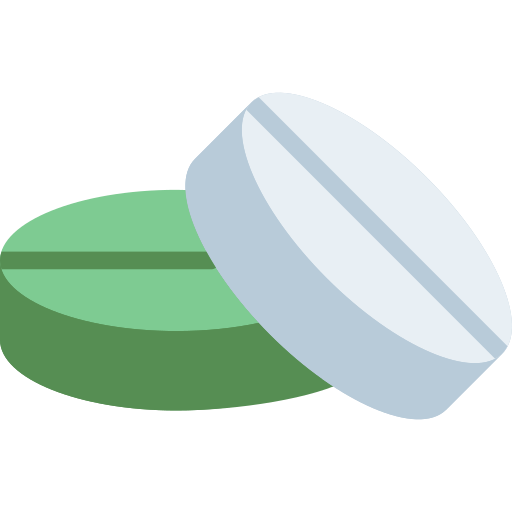
Chlorthalidone
25 mg
Beximco Pharmaceuticals Ltd.
Product Details
Description
Anuria, severe renal failure (creatinine clearance lower than 30 mL/min), severe hepatic failure, refractory hypokalemia or conditions involving enhanced potassium loss, hyponatremia, hypercalcemia, symptomatic hyperuricemia (history of gout or uric acid calculi). Hypersensitivity or suspected hypersensitivity to Chlorthalidone and other sulfonamide derivatives or their excipients. Should be used with caution in patients with renal disease or with impaired hepatic function. Because of the possibility of progression of renal damage, periodic determination of the BUN and serum creatinine are indicated. Should there be an elevation of either parameter, treatment should be discontinued. Like thiazides, Chlorthalidone may lose its diuretic efficacy when glomerular filtration rate drops below 30 mL/min, a point at which treatment with loop diuretics may be more appropriate. Electrolytes: As with thiazide diuretics, kaluresis induced by Chlorthalidone is dose dependent, and there is inter-individual variability in magnitude. With 25 mg/day, serum potassium concentration decreases average 0.5 mmol/L. If chronic treatment is contemplated, serum potassium concentrations should be determined initially, and then 3 to 4 weeks later. If thereafter, potassium balance is not disturbed further, concentrations should be assessed every 4 to 6 months. Conditions that may alter potassium balance include: vomiting, diarrhea, malnutrition, change in renal function (e.g. nephrosis), liver cirrhosis, hyperaldosteronism, or concomitant use of corticosteroids or ACTH. Titrated co-administration of an oral potassium salt (e.g. KCI) may be considered in patients: receiving digitalis; exhibiting signs of coronary heart disease, unless they are also receiving an ACE inhibitor; on high doses of a beta-adrenergic agonist; whose plasma potassium concentrations are less than 3.0 mmol/L.
Electrolytes and Metabolic Disorders: Frequent: mainly at higher doses, hypokalemia, hyperuricemia and rise in blood lipids. Occasional: hyponatremia, hypomagnesemia and hyperglycemia. Rare: hypercalcemia, glycosuria, worsening of diabetic metabolic state and gout. Isolated cases: hypochloremic alkalosis. Dermatology: Occasional: urticaria and other forms of skin rash. Rare: photosensitization. Liver: Rare: Intrahepatic cholestasis or jaundice. Cardiovascular: Occasional: postural hypotension, which may be aggravated by alcohol, anesthetics or sedatives. Rare: cardiac arrhythmias. CNS: Occasional: dizziness, slow mentation and decreased reaction time.
Pregnancy: Chlorthalidone, like other diuretics, can cause placental hypoperfusion. Since they do not prevent or alter the course of EPH (edema, proteinuria, hypertension) preeclampsia, these drugs must not be used to treat hypertension in pregnant women. The use of Chlorthalidone for other indications (e.g. heart disease) in pregnancy should be avoided, particularly in the first trimester, unless the potential benefits outweigh the possible risks (e.g. when there are no safer altenatives). Lactation: Chlorthalidone appears in breast milk, attaining concentrations of approximately 4% of maternal blood levels. Therefore use in nursing mothers should be avoided.
Renal impairment: Chlorthalidone dosage should be reduced in moderate renal failure - every 24 or 48 h - and should not be used in advanced renal failure. Liver disease: There is a risk of precipitating hepatic encephalopathy in patients with liver cirrhosis and ascites. Use in pregnancy: It is better to avoid Chlorthalidone as it crosses the placenta. Use in Lactation: In lactating mother, significant amount of Chlorthalidone enter breast milk; like other long-acting thiazides, it can suppress lactation. Chlorthalidone should not be prescribed for lactating mother.
Symptoms of acute overdosage include nausea, weakness, dizziness, and disturbances of electrolyte balance. The oral LD 50 of the drug in the mouse and the rat is more than 25,000 mg/kg body weight. The minimum lethal dose (MLD) in humans has not been established. There is no specific antidote, but gastric lavage is recommended, followed by supportive treatment. Where necessary, this may include intravenous dextrose-saline with potassium, administered with caution.
Thiazide diuretics & related drugs
Store in a cool and dry place, protected from light.
-
Support 24/7
Call us anytime -
100% Safety
Only secure payments